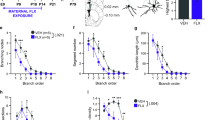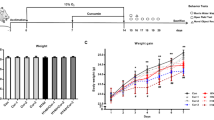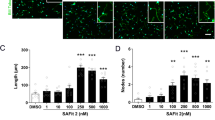Abstract
Chronic administration of antidepressant drugs produce changes in neuroplasticity and behavior in rodents, effects that may be associated with the slow emergence of clinical therapeutic effects. Owing to the uncertainty over the effects of chronic antidepressant treatments in mice, these experiments compared the regulation of neurogenesis, neurotrophin levels, and behavior produced by chronic antidepressant treatments between two inbred mouse strains, MRL/MpJ and C57BL/6J. The MRL/MpJ strain is associated with enhanced wound healing and tissue regeneration, whereas C57BL/6J mice are used commonly for behavioral studies. Proliferation and survival of hippocampal progenitor cells were measured using flow cytometry, a new platform that rapidly quantifies the incorporation of 5-bromo-2-deoxyuridine (BrdU). Hippocampal cell proliferation was increased significantly after chronic administration of fluoxetine (FLX: 5, 10 mg/kg, intraperitoneal (i.p.), b.i.d.) or desipramine (DMI: 5, 10 mg/kg, i.p., b.i.d.) for 21 days in MRL/MpJ mice, but not in C57BL/6J mice. Hippocampal progenitor cells born prior to chronic antidepressant treatments were not affected in either mouse strain. Protein levels of brain-derived neurotrophic factor (BDNF) in MRL/MpJ mice were elevated significantly in the frontal cortex, hippocampus, and amygdala after chronic FLX treatment, but increased only in the frontal cortex by chronic DMI. In contrast, BDNF levels in C57BL/6J mice were decreased in the hippocampus and increased in the amygdala after chronic FLX, and were decreased in the brain stem after chronic DMI. Novelty-induced hypophagia (NIH) was used to examine a behavioral effect produced by chronic antidepressant treatment. MRL/MpJ mice, chronically administered FLX or DMI, had significantly shorter latencies to consume food when exposed to a novel environment than untreated mice, whereas there were no effects on the behavior of C57BL/6J mice. In conclusion, robust effects of chronic antidepressant treatments on hippocampal cell proliferation and BDNF levels paralleled the ability of these drugs to produce changes in NIH behavior in MRL/MpJ, while none of these effects were produced in C57BL/6J mice. The greater responsiveness of MRL/MpJ mice may be important for drug discovery, for genetic studies, and for understanding the neural mechanisms underlying the physiological and behavioral effects of chronic antidepressant treatments.
Similar content being viewed by others
Log in or create a free account to read this content
Gain free access to this article, as well as selected content from this journal and more on nature.com
or
References
Airan RD, Meltzer LA, Roy M, Gong Y, Chen H, Deisseroth K (2007). High-speed imaging reveals neurophysiological links to behavior in an animal model of depression. Science 317: 819–823.
Altar CA, Whitehead RE, Chen R, Wortwein G, Madsen TM (2003). Effects of electroconvulsive seizures and antidepressant drugs on brain-derived neurotrophic factor protein in rat brain. Biol Psychiatry 54: 703–709.
Baker KL, Daniels SB, Lennington JB, Lardaro T, Czap A, Notti RQ et al (2006). Neuroblast protuberances in the subventricular zone of the regenerative MRL/MpJ mouse. J Comp Neurol 498: 747–761.
Balu DT, Hodes GE, Hill TE, Ho N, Rahman Z, Bender CN et al (2008a). Flow cytometric analysis of BrdU incorporation as a high-throughput method for measuring adult neurogenesis in the mouse. J Pharmacol Toxicol Methods doi:10.1016/j.vascn.2008.12.002.
Balu DT, Hoshaw BA, Malberg JE, Rosenzweig-Lipson S, Schechter LE, Lucki I (2008b). Differential regulation of central BDNF protein levels by antidepressant and non-antidepressant drug treatments. Brain Res 1211: 37–43.
Balu DT, Lucki I (2008). Adult hippocampal neurogenesis: regulation, functional implications, and contribution to disease pathology. Neurosci Biobehav Rev doi:10.1016/j.neubiorev.2008.08.007.
Beauquis J, Roig P, Homo-Delarche F, De Nicola A, Saravia F (2006). Reduced hippocampal neurogenesis and number of hilar neurones in streptozotocin-induced diabetic mice: reversion by antidepressant treatment. Eur J Neurosci 23: 1539–1546.
Bechtholt AJ, Valentino RJ, Lucki I (2008). Overlapping and distinct brain regions associated with the anxiolytic effects of chlordiazepoxide and chronic fluoxetine. Neuropsychopharmacology 33: 2117–2130.
Bilsland JG, Haldon C, Goddard J, Oliver K, Murray F, Wheeldon A et al (2006). A rapid method for the quantification of mouse hippocampal neurogenesis in vivo by flow cytometry. Validation with conventional and enhanced immunohistochemical methods. J Neurosci Methods 157: 54–63.
Caldarone BJ, Harrist A, Cleary MA, Beech RD, King SL, Picciotto MR (2004). High-affinity nicotinic acetylcholine receptors are required for antidepressant effects of amitriptyline on behavior and hippocampal cell proliferation. Biol Psychiatry 56: 657–664.
Clark LD, Clark RK, Heber-Katz E (1998). A new murine model for mammalian wound repair and regeneration. Clin Immunol Immunopathol 88: 35–45.
Conti AC, Cryan JF, Dalvi A, Lucki I, Blendy JA (2002). cAMP response element-binding protein is essential for the upregulation of brain-derived neurotrophic factor transcription, but not the behavioral or endocrine responses to antidepressant drugs. J Neurosci 22: 3262–3268.
Coppell AL, Pei Q, Zetterstrom TS (2003). Bi-phasic change in BDNF gene expression following antidepressant drug treatment. Neuropharmacology 44: 903–910.
Crowley JJ, Blendy JA, Lucki I (2005). Strain-dependent antidepressant-like effects of citalopram in the mouse tail suspension test. Psychopharmacology (Berl) 183: 257–264.
Dias BG, Banerjee SB, Duman RS, Vaidya VA (2003). Differential regulation of brain derived neurotrophic factor transcripts by antidepressant treatments in the adult rat brain. Neuropharmacology 45: 553–563.
Dranovsky A, Hen R (2006). Hippocampal neurogenesis: regulation by stress and antidepressants. Biol Psychiatry 59: 1136–1143.
Dulawa SC, Hen R (2005). Recent advances in animal models of chronic antidepressant effects: the novelty-induced hypophagia test. Neurosci Biobehav Rev 29: 771–783.
Dulawa SC, Holick KA, Gundersen B, Hen R (2004). Effects of chronic fluoxetine in animal models of anxiety and depression. Neuropsychopharmacology 29: 1321–1330.
Duman RS, Monteggia LM (2006). A neurotrophic model for stress-related mood disorders. Biol Psychiatry 59: 1116–1127.
Encinas JM, Vaahtokari A, Enikolopov G (2006). Fluoxetine targets early progenitor cells in the adult brain. Proc Natl Acad Sci USA 103: 8233–8238.
Elmariah SB, Hughes EG, Oh EJ, Balice-Gordon RJ (2005). Neurotrophin signaling among neurons glia during formation of tripartite synapses. Neuron Glia Biol 1: 1–11.
Frazer A (2001). Serotonergic and noradrenergic reuptake inhibitors: prediction of clinical effects from in vitro potencies. J Clin Psychiatry 62 (Suppl 12): 16–23.
Gur TL, Conti AC, Holden J, Bechtholt AJ, Hill TE, Lucki I et al (2007). cAMP response element-binding protein deficiency allows for increased neurogenesis and a rapid onset of antidepressant response. J Neurosci 27: 7860–7868.
Heber-Katz E, Leferovich J, Bedelbaeva K, Gourevitch D, Clark L (2004). The scarless heart and the MRL mouse. Philos Trans R Soc Lond B Biol Sci 359: 785–793.
Holick KA, Lee DC, Hen R, Dulawa SC (2008). Behavioral effects of chronic fluoxetine in BALB/cJ mice do not require adult hippocampal neurogenesis or the serotonin 1A receptor. Neuropsychopharmacology 33: 406–417.
Jiang W, Zhang Y, Xiao L, Van Cleemput J, Ji SP, Bai G et al (2005). Cannabinoids promote embryonic and adult hippocampus neurogenesis and produce anxiolytic- and antidepressant-like effects. J Clin Invest 115: 3104–3116.
Lagace DC, Fischer SJ, Eisch AJ (2007). Gender and endogenous levels of estradiol do not influence adult hippocampal neurogenesis in mice. Hippocampus 17: 175–180.
Leferovich JM, Bedelbaeva K, Samulewicz S, Zhang XM, Zwas D, Lankford EB et al (2001). Heart regeneration in adult MRL mice. Proc Natl Acad Sci USA 98: 9830–9835.
Lucki I, Dalvi A, Mayorga AJ (2001). Sensitivity to the effects of pharmacologically selective antidepressants in different strains of mice. Psychopharmacology (Berl) 155: 315–322.
Malberg JE, Eisch AJ, Nestler EJ, Duman RS (2000). Chronic antidepressant treatment increases neurogenesis in adult rat hippocampus. J Neurosci 20: 9104–9110.
Mamounas LA, Blue ME, Siuciak JA, Altar CA (1995). Brain-derived neurotrophic factor promotes the survival and sprouting of serotonergic axons in rat brain. J Neurosci 15: 7929–7939.
Manev H, Uz T, Smalheiser NR, Manev R (2001). Antidepressants alter cell proliferation in the adult brain in vivo and in neural cultures in vitro. Eur J Pharmacol 411: 67–70.
Merali Z, Levac C, Anisman H (2003). Validation of a simple, ethologically relevant paradigm for assessing anxiety in mice. Biol Psychiatry 54: 552–565.
Miller BH, Schultz LE, Gulati A, Cameron MD, Pletcher MT (2008). Genetic regulation of behavioral and neuronal responses to fluoxetine. Neuropsychopharmacology 33: 1312–1322.
Nakagawa S, Kim JE, Lee R, Chen J, Fujioka T, Malberg J et al (2002). Localization of phosphorylated cAMP response element-binding protein in immature neurons of adult hippocampus. J Neurosci 22: 9868–9876.
Navailles S, Hof PR, Schmauss C (2008). Antidepressant drug-induced stimulation of mouse hippocampal neurogenesis is age-dependent and altered by early life stress. J Comp Neurol 509: 372–381.
Nestler EJ, Gould E, Manji H, Buncan M, Duman RS, Greshenfeld HK et al (2002). Preclinical models: status of basic research in depression. Biol Psychiatry 52: 503–528.
Nibuya M, Morinobu S, Duman RS (1995). Regulation of BDNF and trkB mRNA in rat brain by chronic electroconvulsive seizure and antidepressant drug treatments. J Neurosci 15: 7539–7547.
Richelson E (2003). Interactions of antidepressants with neurotransmitter transporters and receptors and their clinical relevance. J Clin Psychiatry 64 (Suppl 13): 5–12.
Sairanen M, Lucas G, Ernfors P, Castrén M, Castrén E (2005). Brain-derived neurotrophic factor and antidepressant drugs have different but coordinated effects on neuronal turnover, proliferation, and survival in the adult dentate gyrus. J Neurosci 25: 1089–1094.
Santarelli L, Saxe M, Gross C, Surget A, Battaglia F, Dulawa S et al (2003). Requirement of hippocampal neurogenesis for the behavioral effects of antidepressants. Science 301: 805–809.
Shankaran M, King C, Lee J, Busch R, Wolff M, Hellerstein MK (2006). Discovery of novel hippocampal neurogenic agents by using an in vivo stable isotope labeling technique. J Pharmacol Exp Ther 319: 1172–1181.
Shors TJ, Mathew J, Sisti HM, Edgecomb C, Beckoff S, Dalla C (2007). Neurogenesis and helplessness are mediated by controllability in males but not in females. Biol Psychiatry 62: 487–495.
Song L, Che W, Min-Wei W, Murakami Y, Matsumoto K (2006). Impairment of the spatial learning and memory induced by learned helplessness and chronic mild stress. Pharmacol Biochem Behav 83: 186–193.
Thompson A, Boekhoorn K, Van Dam AM, Lucassen PJ (2008). Changes in adult neurogenesis in neurodegenerative diseases: cause or consequence? Genes Brain Behav 7 (Suppl 1): 28–42.
Tsankova NM, Berton O, Renthal W, Kumar A, Neve RL, Nestler EJ (2006). Sustained hippocampal chromatin regulation in a mouse model of depression and antidepressant action. Nat Neurosci 9: 519–525.
Wang JW, David DJ, Monckton JE, Battaglia F, Hen R (2008). Chronic fluoxetine stimulates maturation and synaptic plasticity of adult-born hippocampal granule cells. J Neurosci 28: 1374–1384.
Zhao C, Deng W, Gage FH (2008). Mechanisms and functional implications of adult neurogenesis. Cell 132: 645–660.
Acknowledgements
This research was conducted by a National Center for Drug Discovery Group (NCDDG) in Mood Disorders established between the University of Pennsylvania and Wyeth Research and funded by USPHS Grant MH72832. We are grateful for the critical comments and advice provided by Dr Julie Blendy at the University of Pennsylvania and Drs Lee Schechter, Robert Ring, and Zia Rahman at Wyeth Research, and other members of the NCDDG. We thank Hank Pletcher of the University of Pennsylvania Flow Cytometry Center for his assistance in developing some of the techniques described in this paper. We also thank Gina Colaizzo for her excellent technical assistance.
Author information
Authors and Affiliations
Corresponding author
Additional information
DISCLOSURE/CONFLICT OF INTEREST
Dr Lucki is a member of the Neuroscience Scientific Advisory Board for Wyeth Research, and has received research support from AstraZeneca Pharmaceuticals, Forest Laboratories, and Epix Pharmaceuticals during the past 3 years. There are no other disclosures.
Rights and permissions
About this article
Cite this article
Balu, D., Hodes, G., Anderson, B. et al. Enhanced Sensitivity of the MRL/MpJ Mouse to the Neuroplastic and Behavioral Effects of Chronic Antidepressant Treatments. Neuropsychopharmacol 34, 1764–1773 (2009). https://doi.org/10.1038/npp.2008.234
Received:
Revised:
Accepted:
Published:
Issue date:
DOI: https://doi.org/10.1038/npp.2008.234
Keywords
This article is cited by
-
The engine initiating tissue regeneration: does a common mechanism exist during evolution?
Cell Regeneration (2021)
-
Gamma-H2AX upregulation caused by Wip1 deficiency increases depression-related cellular senescence in hippocampus
Scientific Reports (2016)
-
Antidepressant-like Effects of Buprenorphine are Mediated by Kappa Opioid Receptors
Neuropsychopharmacology (2016)
-
Effects of buprenorphine on behavioral tests for antidepressant and anxiolytic drugs in mice
Psychopharmacology (2015)
-
Fine-mapping quantitative trait loci affecting murine external ear tissue regeneration in the LG/J by SM/J advanced intercross line
Heredity (2014)



